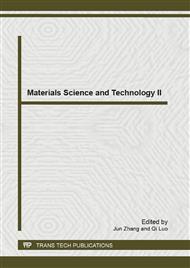[1]
FANZhenxiang.,&CHENGHaifeng.(2005).Development of Thermal Protection Materials. Materials Review, 19,13-16.
Google Scholar
[2]
KatzmanHA, Ma]lonJ, BarryWT.J. AdvMater,1995,4:21
Google Scholar
[3]
Max I B. Advanced metallic thermal protection systems for reusable launch vehicle. University of Virginia, (2000)
Google Scholar
[4]
Behrens B,Muller M. Technologies for thermal protection systems applied on re-usable launcher. Acta Astronautica, 2004, 55:52
DOI: 10.1016/j.actaastro.2004.05.034
Google Scholar
[5]
SHI Zhenhai,LI Kezhi,LI Hejun,TIAN Zhu.(2007) Research Status and Application Advance of Heat Resistant Materials for Space Vehicle. Materials Review, 21, 8:15-17.
Google Scholar
[6]
Messinger R,Pulley J. Thermal-mechanical Cycle Test of A Cryogenic Tank of RLV[R].AIAA-2003-1766.
Google Scholar
[7]
T.R. Crompton. (2010).Thermo-oxidative Degradation of Polymers. Lightning Source Inc.
Google Scholar
[8]
Jigang Wang.,& NanJiang.(2009).Effect of the evolution of phenol–formaldehyde resin on the high-temperature bonding. Adhesion & Adhesives, 29, 718-723.
DOI: 10.1016/j.ijadhadh.2009.03.001
Google Scholar
[9]
Mohamed O. Abdalla.,&Adriane Ludwick.(2003).Boron-modified phenolic resins for high performance applications.Polymer,44,7353-7359.
DOI: 10.1016/j.polymer.2003.09.019
Google Scholar
[10]
Kimberly A. Trick & Tony es. Aliba. (1995). Mechanisms of the pyrolysis of phenolic resin in a carbon/phenolic composite. Elsevier Science Ltd.
Google Scholar
[11]
Mckee DW, Spiro CL, Lamby EJ. Carbon 1984;22:507–11.
Google Scholar
[12]
Duan-Chih Wang.,&Geng-Wen Chang. (2008). Preparation and thermal stability of boron-containing phenolic resin/clay nanocomposites. Polymer Degradation & Stability, 93, 125-133.
DOI: 10.1016/j.polymdegradstab.2007.10.021
Google Scholar
[13]
L. G. Hanu, G. P. Simon, Y. B. Cheng. Preferential orientation of muscovite in ceramifiable silicone composites. Materials Science and Engineering A, 2005, 398: 180~187
DOI: 10.1016/j.msea.2005.03.022
Google Scholar
[14]
L. G. Hanu, G. P. Simon, J. Mansouri, R.P. Burford, Y.B. Cheng. Development of polymer–ceramic composites for improved fire resistance. Journal of Materials Processing Technology, 2004, 153: 401~407
DOI: 10.1016/j.jmatprotec.2004.04.104
Google Scholar
[15]
Mansouri J, Wood A, Roberts K, Cheng Y-B, Burford RP. Investigation of the ceramifying process of modified silicone–silicate compositions. J. Mater. Sci., 2007, 42: 6046~6055
DOI: 10.1007/s10853-006-1163-8
Google Scholar
[16]
Mansouri J, Burford RP, Cheng YB, Hanu L. Formation of strong ceramified ash from silicone-based compositions. J Mater Sci, 2005, 40: 5741~5749
DOI: 10.1007/s10853-005-1427-8
Google Scholar
[17]
J. Mansouri, R.P. Burford, Y.B. Cheng. Pyrolysis behaviour of silicone-based ceramifying composites. Materials Science and Engineering A, 2006, 425: 7~14
DOI: 10.1016/j.msea.2006.03.047
Google Scholar
[18]
L. G. Hanu, G. P. Simon, Y. B. Cheng. Thermal stability and flammability of silicone polymer composites. Polymer Degradation and Stability, 2006, 91: 1373~1379
DOI: 10.1016/j.polymdegradstab.2005.07.021
Google Scholar
[19]
Juliana Anggonol, Brian Derby. Pyrolysis of aluminium loaded polymethylsiloxanes: the influence of Al/PMS ratio on mullite formation. J Mater Sci, 2010, 45: 233–241
DOI: 10.1007/s10853-009-3925-6
Google Scholar


